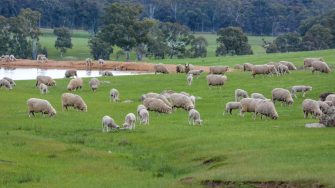Livestock vaccine manufactured in NSW for first time by UNSW RNA Institute
Learnings from the successful pilot project are now being applied to the development of emergency animal disease vaccines.
Learnings from the successful pilot project are now being applied to the development of emergency animal disease vaccines.

The NSW Government pilot project to fast-track an mRNA vaccine for border disease virus (BDV) has been successfully manufactured for the first time in NSW.
The manufacture of the BDV vaccine by UNSW Sydney scientists has since led to the development of cutting - edge emergency animal disease vaccines, which have reached a major research milestone.
Border disease virus (BDV) is a congenital disease affecting sheep and goats. Affected lambs are undersized with extremely hairy coats and may exhibit involuntary muscular tremors. Currently, no effective treatment is known.
The BDV vaccine was manufactured by the UNSW RNA Institute after first being developed by US-based biotechnology leader, Tiba Biotech, with input from the Canadian Food Inspection Agency (CFIA), NSW Department of Primary Industries (DPI), Queensland Department of Agriculture and Fisheries, Meat & Livestock Australia and the NSW RNA Pilot Facility.
“The UNSW RNA Institute is very proud to have been part of this project. I grew up on a farm on an island and understand well the importance of biosecurity for farmers, our consumers and the welfare of our animals,” says Professor Pall Thordarson, Director of the UNSW RNA Institute. “The mRNA vaccine technology is going to be another powerful tool in our biosecurity toolkit and in this project we have shown that we are capable of rapidly making that tool here in Australia.”
While BDV is not an emergency animal disease, the learnings from this successful pilot project are now being applied to the development of vaccines for lumpy skin disease (LSD) and foot-and-mouth disease (FMD), from which Australia remains free.
“Developing local capacity to produce vaccines against emergency animal diseases is a critical priority for Australian agricultural industries and the economy,” says Tara Moriarty, Minister for Agriculture, Regional and Western NSW.
“Now we have success with a virus which exists in Australia, we are working to establish a vaccine pipeline for priority animal diseases, including lumpy skin disease and foot-and-mouth disease, to ensure Australia can manufacture vaccines during an emergency response.”
Economic costs of a large multi-state outbreak of FMD alone have been estimated at more than $80 billion over 10 years Australia-wide, which is why the NSW Government is working with state, territory and national governments and animal industries to safeguard livestock from these key biosecurity threats.
The project team are now investigating whether protective antigens, identified by the CFIA, work against LSD. The UNSW RNA Institute will continue to refine the manufacturing process to minimize delays for upscaling mRNA manufacturing.
This means that in the case of a biosecurity emergency, the UNSW RNA Institute will have the knowledge and experience to rapidly transfer the project to the NSW RNA Pilot Facility manufacturing mRNA plant that the NSW Government is building at Macquarie University, with Myeloid Therapeutics as the operating partner.
All work with live viruses is being conducted overseas, while NSW DPI scientists at the Elizabeth Macarthur Agricultural Institute work on establishing the immune response, demonstrating animal safety and optimising the formulation and dose.
Work so far indicates that the test LSD mRNA vaccine is quickly metabolised and cleared from the animal. Australian regulatory authorities have very strict standards to demonstrate that the vaccine will be cleared from the animal very rapidly and that there is no safety risk to people.